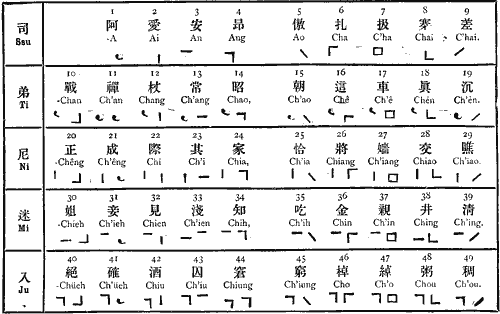Explanation of Mr. Murray's System for Teaching Sighted Chinese to Read and Write.
by Professor S. M. Russell, M.A.
Imperial College Peking
For many years the Rev. W. H. Murray, agent of the National Bible Society of Scotland, has worked among the Blind in China. No one who has visited his school in Peking can have failed to have been struck with the rapidity and correctness with which his pupils read and write.
Owing to his great success in teaching the blind, Mr. Murray conceived the idea that the same system might be readily acquired by illiterate men and women, who, although endowed with sight, had not the time or ability to learn the Chinese hieroglyphics.
As the system for the Seeing and the Blind are exactly the same in principle, I shall explain the former only. There are 408 sounds in the Chinese Mandarin dialect. These sounds are given in Table A, in rows of ten characters. The first and last rows contain only nine characters.
Above each character is written its number in the series, from No. 1 to 408.
Below each character is written its pronunciation in the Pekingese dialect; but of course a person in, say Shantung, would give the Shantung pronunciation. Underneath the pronunciation of each character is its symbol in Mr. Murray's notation, representing numerals.
The first thing for the pupil to do is to learn by heart these 408 sounds, and the number corresponding to each tenth sound. For instance, he must remember that 390 is Yen, that 160 is K'uan, and so on. Mr. Murray makes this comparatively easy by a system of Mnemonics, which I shall now explain.
System of Mnemonics for Learning the 408 Sounds.
In Table A, at the beginning of each lineJ and forming a separate column, are placed the characters Ssu, Ti, Ni, Mi, &c.* These are the Mnemonic sounds, and stand for numbers.
In Table B, I give the Mnemonic sounds in ten squares.
The sounds in the first square, Tan, Ti, &c., all represent One; Ni, Ha, Nan, in the second square, all stand for two, and so on. Those in the tenth square, Hsü, Ssû, Suan, all stand for the 0, as in 200, 300, &c.
The pupil first learns Table B thoroughly, so that if the teacher says 5, the pupil at once repeats Lai, Li, &c.; or if the teacher says 8, the pupil answers, Fen, Fa, &c.; or if the teacher says Ling, the pupil answers, Hsü, Ssû, Suan; and vice versâ if the teacher says Pai, the pupil answers 9.
Having learned Table B thoroughly, the pupil learns Table A.
Method of Learning Table A.
The pupil begins by learning the Mnemonic sound, coupled with the first sound in each row of ten, as Ssu A (1), Ti Chan (10), Ni Cheng (20), Mi Chieh (30), Ju Chüeh (40), Ta suan Huan (100), Ju Ssu-yung (400). Nearly all of these have a meaning which helps to fix it in the memory.
System of Mnemonics for Learning the 408 Sounds.
A glance at Table A shows at the beginning of each line the characters Ssu, Ti, Ni, Mi, &c. These are the Mnemonic sounds, and stand for numbers. In Table B I give the Mnemonic sounds in ten squares:
Table B
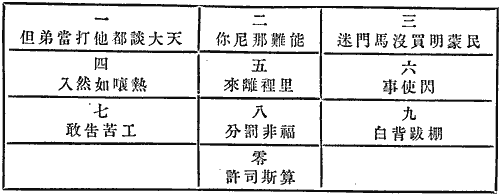
The sounds in the 1st square, Tan, Ti, &c., all represent One.
Ni, Na, Nan, in the 2nd square, all stand for Two, and so on.
Those in the 10th square, Hsü, Ssu, Suan, all stand for the 0, as in 200.
This must be learned thoroughly, so that if the teacher says, for instance, T'a Shih, the pupil at once says, K'uan (160), or vice versâ.
The use of Mnemonics in Table B is now evident; for instance, if the pupil says T'a Men Jo, he knows at once that Jo is the 130th sound; for T'a stands for 1, and Men for 3, and likewise for all the others.
Having now learned the first sound in each row, according to the above method, the pupil learns each row of ten separately as A, Ai, An, &c., and Chan, Ch'an, Chang, &c.
The teacher should now question the pupil as to his knowledge of Table A. For instance, if he asks what is the 64th sound, the pupil should at once recollect that 6 is the Mnemonic Shan, and so Ch'ua is 60, and counting 4 further on, get Ch'uan for 64. At the beginning the pupil must so count, but with a little practice, the mental process is performed with almost automatic rapidity, and the eye learns to recognize thc symbol, as quickly as a Chinese scholar recognizes a character.*
NOTATION
According to Mr. Murray's system, instead of writing the sound, the pupil writes only the number of the sound as given in Table A.
For the Blindt Mr. Murray uses Braille's elements (i.e. embossed dots). For the Seeing, the dots in Braille's elements are joined by lines. The Notation for the Seeing exactly corresponds with that for the Blind.
Thus the Blind can set up the type, and prepare books for those endowed with Sight.
Table C shows the elements used for the Blind, and Table D those used for the Seeing.
Table C
For the Blind

Embossed in white dots.
Table D
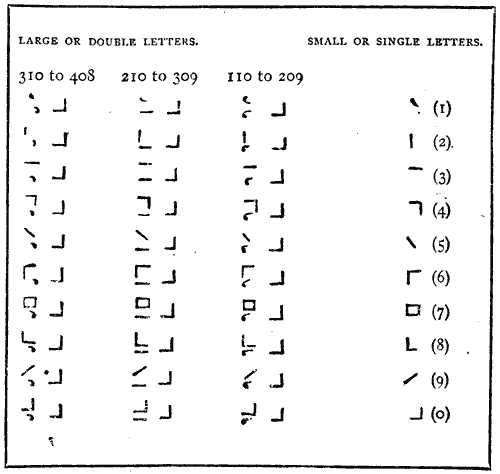
For details see Table A.
How the Tones are Indicated.
The sounds in Table A, from one to nine inclusive, are indicated by one single letter, so that there is one space left vacant. "High or low to the left indicate lst or 2nd tone, and high or low to the right, the 3rd or 4th tone. For instance, sound No. 1 a in the four tones is expressed as follows:
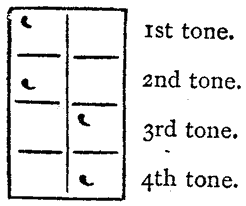
All sounds from the l0th to the l09th are expressed by two single letters. Both letters high, indicate the lst tone; both low, the 2nd tone. First letter low, second high, the 3rd tone, and the reverse the 4th tone.
Thus the nineteenth sound, Ch'en, is expressed in the four tones as follows:
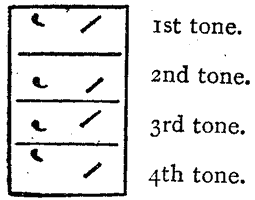
All sounds from lst to 109th, that is, those expressed by small or single letters, are read from left to right.
All sounds from 110th to the end consist, as we have seen, of a large or double letter, and a small or single.
The small letter on the left, high or low, indicates lst or 2nd tone. The small letter on the right, high or low, indicates the 3rd or 4th tone. Thus for the lst or 2nd tone we read from right to left, and for the 3rd or 4th tone, from left to right. In fact we always read from the double letter. As an example I give the 287th sound Sung in the 4 tones:
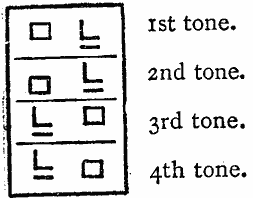
I have gone into the above at full length, but one learns in a few minutes the notation, and the method of indicating the tones. Since this was written Mr. Murray has added a very simple symbol to denote the 5th tone, which occurs in certain Provinces.
An easy reading lesson is next given, with the number in our notation and the
corresponding sound and tone. Thus ![]() is 127, 2nd tone, as small letter is low on the left, and looking up
Table A we see that the 127th sound is "jen2".
is 127, 2nd tone, as small letter is low on the left, and looking up
Table A we see that the 127th sound is "jen2". ![]() is 34, 1st tone, as small letter is high on the left. After some practice
in reading, the pupil recognizes a symbol directly without thinking of the number it
represents. Indeed, he recognizes the symbol as a Chinaman recognizes a
character.
is 34, 1st tone, as small letter is high on the left. After some practice
in reading, the pupil recognizes a symbol directly without thinking of the number it
represents. Indeed, he recognizes the symbol as a Chinaman recognizes a
character.
Note. -- In certain Provinces a 5th tone occurs. Mr. Murray has devised a special symbol to express this.
Reading Lesson.
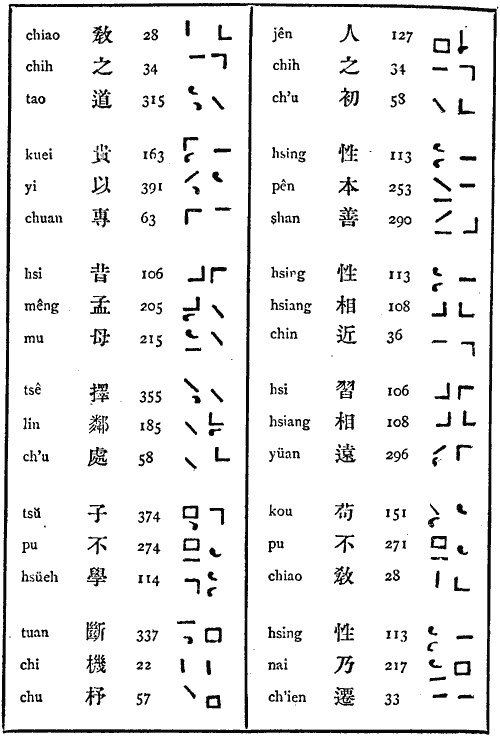
Advantages of Mr. Murray's System.
It is quite as easily learnt as the Romanized -- indeed more easily. Once acquired it can be read much more fluently and correctly. As each word consists of only two letters (or parts), they catch the eye at once, whereas in the Romanized the eye has to glance over several letters forming one word.
In the Romanized system the sound is indicated by a system of initials and finals, so that it is often very difficult to represent the exact sound. In Mr. Murray's system the sound is learned from Table A by means of the Chinese Character*, and is therefore exact.
As it stands, Mr. Murray's system is a universal one for all Mandarin dialects, and by certain modifications it might be adapted to all other dialects. (See note on page 132.)
The pupil learns the 408 sounds direct from the character in Table A. A man of Peking would give his pronunciation, a person from Shantung would give his, one from Nanking his, and so on for the other Mandarin-speaking districts.
Now in the Romanized system a new orthography would be necessary for almost every district. A version in Pekingese would be unintelligible in Shantung, and vice versâ. For example, in the list of sounds in Table A, number 170 is pronounced K'uo in Peking; fifty miles to the south it is pronounced K'ê. Now in the Romanized system such a change of dialect involves great confusion, but in Mr. M urray's system all difficulty disappears. The man of Peking sees the symbol, and reads it K'uo, whilst the man from the country reads it as K'ê, and to each it conveys precisely the same meaning.
As each word consists of two letters only, inclusive of tone, books in this system can be printed very cheaply, whereas in the Romanized many words consist of five or six letters and in addition, aspirates and tones have to be indicated, so that books in the Romanized system must necessarily be bulky and expensive.
The blind can set up the type and print for the seeing, and thus suitable employment may be found for the blind boys and girls in the various Missions.
Another advantage is that Mr. Murray's system is very easily written. A lady who has taught the Romanized tells me that in future she will never teach her women to write, as it is so difficult for them to learn. Whereas the very first class of country women who learned Mr. Murray's system for a period of three months (and who did not begin to learn to write till they had been learning the system for about seven weeks), found that they were able to write letters to their teachers, the writing being good, as well as correct.
